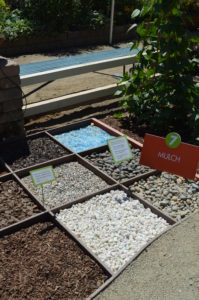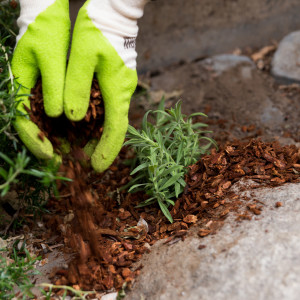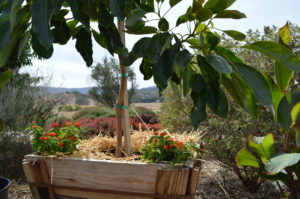The Right Mulch for Your Garden
 Mulch is the finishing touch for your garden and serves many purposes. It minimizes evaporation in the soil, suppresses weeds, moderates soil temperature, minimizes soil erosion, and gives flower and vegetable beds a tidy appearance. There are many materials, both organic and non-organic, that you can use as mulch. Organic mulches have the additional benefits of improving the soil structure and releasing nutrients into the soil as they decompose.
Mulch is the finishing touch for your garden and serves many purposes. It minimizes evaporation in the soil, suppresses weeds, moderates soil temperature, minimizes soil erosion, and gives flower and vegetable beds a tidy appearance. There are many materials, both organic and non-organic, that you can use as mulch. Organic mulches have the additional benefits of improving the soil structure and releasing nutrients into the soil as they decompose.
Every type of mulch has advantages and disadvantages and your choice may take into consideration factors like appearance, durability, accessibility and cost. To choose a mulch for your garden, consider the following pros and cons of some of the best options.
Bark or Wood Chips
 Among the most commonly used mulches, bark and wood chips are easily available in bags or in bulk from some garden centers. Wood chips are slow to deteriorate, and they can temporarily bind up nitrogen in the soil as they do, which robs nearby plants of needed nutrition (but only for a short time). Bark chips can also be toxic to plants if they are too fresh. You can also buy bags of colored wood chip mulches (generally red, brown, and black).
Among the most commonly used mulches, bark and wood chips are easily available in bags or in bulk from some garden centers. Wood chips are slow to deteriorate, and they can temporarily bind up nitrogen in the soil as they do, which robs nearby plants of needed nutrition (but only for a short time). Bark chips can also be toxic to plants if they are too fresh. You can also buy bags of colored wood chip mulches (generally red, brown, and black).
Shredded Redwood “Hair”
Shredded redwood can be a very attractive mulch, and it works particularly well on slopes where rainfall or irrigation might wash away other mulches. The disadvantages are that it’s lightweight and can be blown around, and weed seeds and other debris can get caught in the finely shredded fibers, making it messy.
Alfalfa Hay or Pellets
Alfalfa or hay pellets are a good source of nitrogen for the soil and are seedless and long-lasting compared to rice straw. This is a more expensive option, but since it is pelletized and bagged, it is easy to transport.
Gravel and Decorative Stone
Gravel and other stone has one big advantage over other mulches–you don’t have to replace it every year. It gives a garden a very polished appearance, and if the bed is weed-free before the gravel is laid, it can be an effective weed suppressor. On the other hand, it’s heavy so you may require extra help installing it. It has a higher up-front cost than organic mulches and can be difficult to keep clean in areas with lots of leaf litter and debris.
Cocoa Bean Hulls
This mulch gained a lot of popularity primarily for its fragrance—it smells like chocolate. The downside is the fragrance doesn’t last long, it’s expensive, and it’s lightweight enough to blow away. It can also be toxic for dogs if they should eat it.
Straw mulch can be hard to find in urban and suburban areas but is readily available in rural areas. Rice straw adds nutrients to the soil and doesn’t have seeds, but it deteriorates rather quickly. Wheat or oat straw lasts longer but you have to deal with the seeds first by soaking the straw before spreading it out and allowing the seeds to sprout and die. Straw isn’t expensive and is good at holding moisture in the soil while allowing air to pass through.
Pine Needles and Other Leaf Mulches
If you have a good source for pine needles, you have a gardener’s goldmine. Pine needles make a terrific acidifying mulch. They’re also long lasting and don’t compact too much, making them a good choice for mulching paths in vegetable beds. You may need to screen it first to filter out other debris. Other leaves can be used as well–oak leaf mulch is another good option, although it is not as acidifying as pine needles.
Whichever mulch you choose, it should be spread in a layer 3–4 inches deep. If you measure the square footage of the area you want to cover, your local nursery or garden center can help you calculate how much mulch you’ll need to adequately cover it and consult on the best type of mulch for your area.
